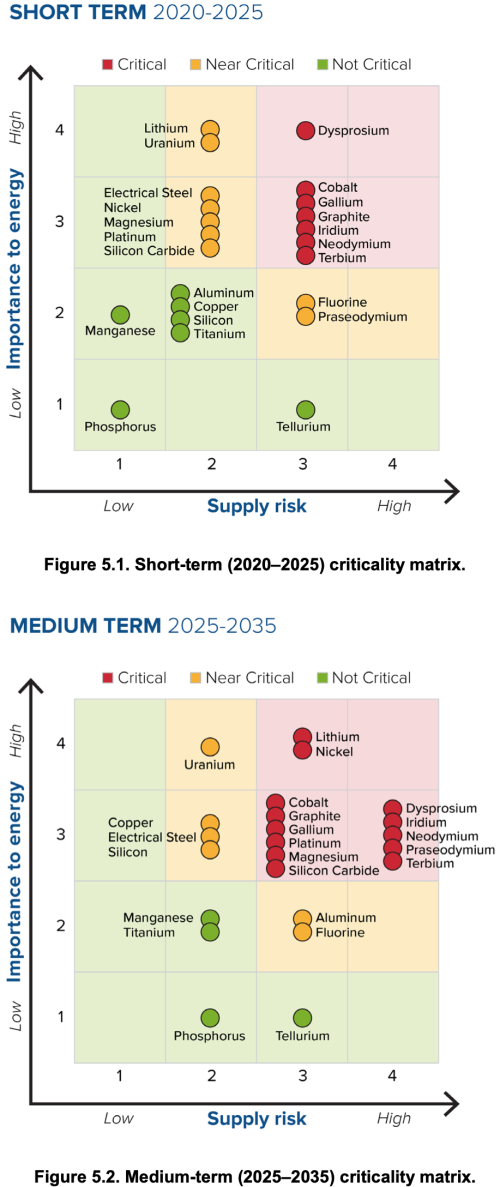Energy & Critical Metals
US DOE releases 2023 Critical Materials Assessment to evaluate supply chain security for clean energy technologies
The US Department of Energy (DOE) released its 2023 Critical Materials Assessment (2023 CMA), which evaluated materials for their criticality to global…

The US Department of Energy (DOE) released its 2023 Critical Materials Assessment (2023 CMA), which evaluated materials for their criticality to global clean energy technology supply chains. Based on the results of the Assessment, DOE has determined the 2023 DOE Critical Materials List of energy-specific critical and near-critical materials through 2035.
In addition to informing crosscutting DOE priorities including the Critical Materials Research, Development, Demonstration, and Commercialization Application Program (RDD&CA), the DOE Critical Materials List will inform eligibility for tax credits under the Inflation Reduction Act 48C.
The Assessment focuses on key materials with high risk of supply disruption that are integral to clean energy technologies. The final list includes aluminum, cobalt, copper, dysprosium, electrical steel (grain-oriented steel, non-grain-oriented steel, and amorphous steel), fluorine, gallium, iridium, lithium, magnesium, natural graphite, neodymium, nickel, platinum, praseodymium, terbium, silicon, and silicon carbide.
Highlights of the findings from the 2023 CMA include:
-
Rare earth materials (neodymium [Nd], praseodymium [Pr], dysprosium [Dy], and terbium [Tb]) used in magnets in EV motors and wind turbine generators continue to be critical. While Dy and Tb are both heavy rare earth elements that serve the same function in magnets, the criticality of Tb is slightly lower than that for Dy in the short term due to the widespread use of Dy in high-grade magnets and Tb’s present role as a substitute. Similarly, Pr is critical in the medium term but only near critical in the short term because it is more substitutable in magnets than Nd.
-
Materials used in batteries for EVs and stationary storage are now considered to be critical. While cobalt (Co) was found to be critical in this and previous reports, lithium (Li) becomes critical in the medium term due to its broader use in various battery chemistries and the rampant growth of the EV industry. Natural graphite is a new addition in this assessment and is also found to be critical.
-
Platinum group metals used in hydrogen electrolyzers, such as platinum (Pr) and iridium (Ir), are critical due to an increased focus on hydrogen technologies to achieve net-zero carbon emissions, whereas those used in catalytic converters, such as rhodium (Rh) and palladium (Pd), were screened out due to the decreased importance of catalytic converters in the medium term.
-
Gallium (Ga) continues to be critical due to its use in light-emitting diodes (LEDs). In addition, the use of Ga has increased in magnet manufacturing and in semiconductors in forms such as gallium arsenide (GaAs) or gallium nitride (GaN).
-
Major materials like aluminum (Al), copper (Cu), nickel (Ni), and silicon (Si) move from noncritical in the short term to near critical in the medium term due to their importance in electrification.
-
Electrical steel is near critical due to its use in transformers for the grid and electric motors in EVs.
Source: 2023 CMA
Because material and technology markets are global, this Critical Materials Assessment features a global scope, placing US domestic interests within that context. For each of the critical materials identified in this Assessment, DOE will develop an integrated strategy to address material-specific risks.
This Assessment is an update of assessments in previous Critical Materials Strategy reports, the first of which was released by DOE in 2010. It serves as a complementary analysis to other criticality assessments conducted by the US government, such as those by the US Geological Survey (USGS) on behalf of the US Department of the Interior, and builds upon DOE’s February 2022 Clean Energy Supply Chain Reports.
This 2023 Critical Materials Assessment was managed and funded EERE’s Advanced Materials and Manufacturing Technologies Office (AMMTO) and was conducted by Argonne National Laboratory and Idaho National Laboratory, in consultation with members of the DOE Critical Minerals and Materials Science and Energy Technology Team.
ax
lithium
cobalt
praseodymium
neodymium
terbium
dysprosium
nickel
copper
aluminum
gallium

Uranium Exploration Company Announces Additional Staking in the Athabasca Basin
Source: Streetwise Reports 12/22/2023
Skyharbour Resources Ltd. announced an update from its Canada-based Falcon Project along with additional…
Tesla Launches New Mega Factory Project In Shanghai, Designed To Manufacture 10,000 Megapacks Per Year
Tesla Launches New Mega Factory Project In Shanghai, Designed To Manufacture 10,000 Megapacks Per Year
Tesla has launched a new mega factory…
Giving thanks and taking stock after “a remarkable year”
An end-of-year thank you to our readers, industry colleagues and advertisers before Electric Autonomy breaks from publishing until Jan. 2
The post Giving…











